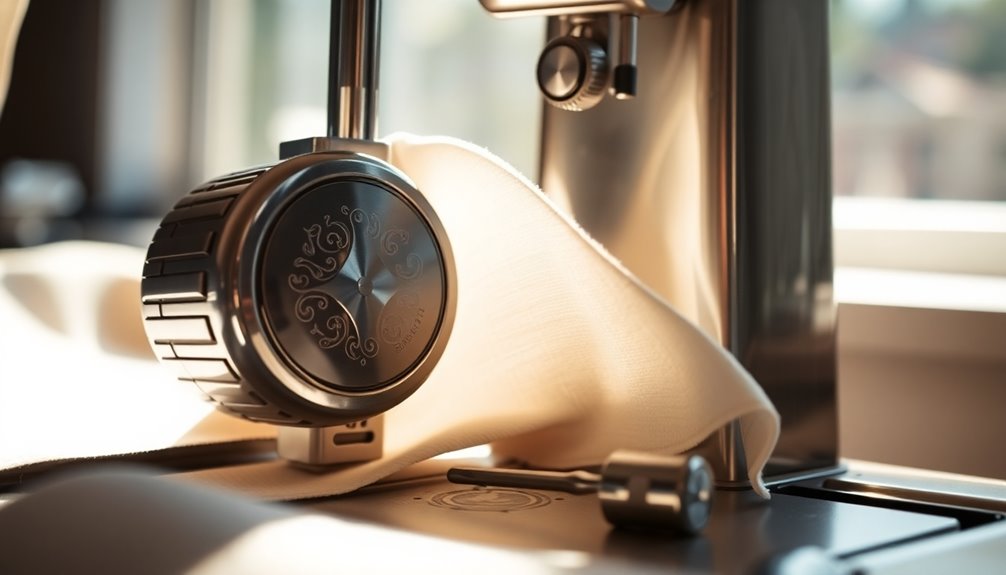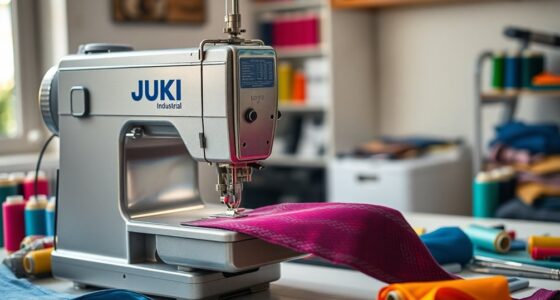If your sewing machine handwheel is jammed, start by checking the presser foot; it should always be lowered before you sew. Next, inspect the bobbin for correct size and insertion. Clear away any lint or debris around the handwheel and loosen any tight screws. Test the machine with a scrap piece of fabric and lubricate the handwheel if needed. With these tips, you can get back to sewing seamlessly, and there's more useful info ahead!
Key Takeaways
- Ensure the presser foot is lowered before sewing to prevent jamming of the handwheel and needle.
- Check for and remove any debris or lint around the handwheel to improve its movement.
- Verify that you are using the correct bobbin size and that it is properly seated in the bobbin case.
- Test the handwheel's movement by turning it with a scrap piece of fabric to identify any issues.
- Regularly lubricate the handwheel and internal gears to prevent sticking and ensure smooth operation.
Reasons for a Stuck Handwheel

When your sewing machine's handwheel gets stuck, it can be frustrating and might halt your project. Several reasons could be behind this issue.
First, if your presser foot isn't lowered, it can cause the needle and handwheel to jam. Additionally, using the wrong bobbin size or improperly inserting the bobbin case can lead to tension problems that restrict movement.
Accumulated debris and lint around the handwheel can also obstruct its function, so make sure to clean that area regularly.
Finally, damaged gears or any obstructions inside the machine may hinder rotation.
To troubleshoot, grab a scrap piece of fabric and gently test the handwheel's movement. Identifying the cause can help you get back to sewing smoothly.
Fixing a Loose Handwheel
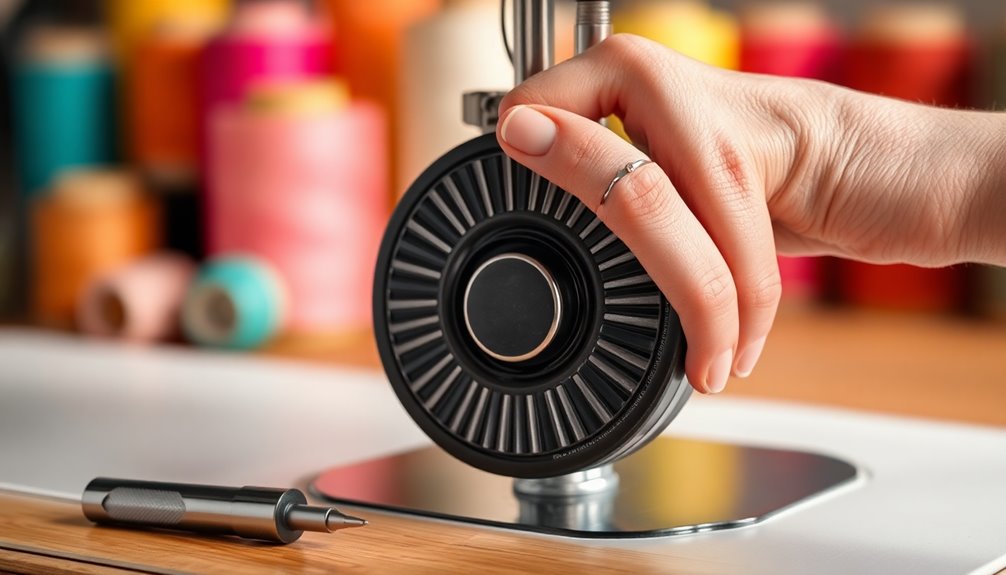
If you notice your sewing machine's handwheel feels loose, addressing the issue promptly can prevent further complications.
Start by confirming that the handwheel is securely attached to the machine. Remove the stitch plate and metal plate to access the handwheel's setscrew. If you find the setscrew is loose, use a screwdriver to tighten it, ensuring a snug fit without over-tightening.
Once you've secured the handwheel, reattach the stitch plate and metal plate to restore your machine to its original condition.
To avoid future problems with a loose handwheel, make regular maintenance a habit by checking the tightness of the handwheel periodically. This simple step can keep your sewing machine running smoothly.
Lowering the Pressure Foot
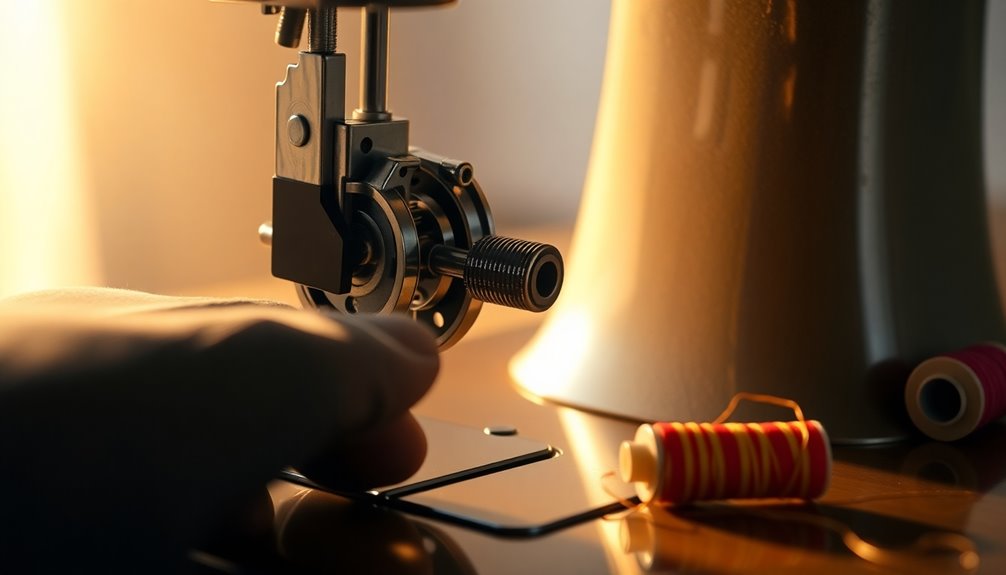
A loose handwheel can lead to various sewing mishaps, including issues with the presser foot. Always verify you're lowering the pressure foot before starting to sew.
This simple step allows the fabric to feed properly and prevents the needle and handwheel from getting stuck. Check the lever located at the back of your machine to lower the presser foot effectively.
If you skip this, you risk jams and increased wear on your machine's components. Newer machines often have indicators or reminders to confirm that the presser foot is lowered, making it easier to avoid this common mistake.
Properly lowered presser feet maintain consistent pressure on the fabric, essential for smooth sewing and preventing future operational issues.
Bobbin Size and Insertion
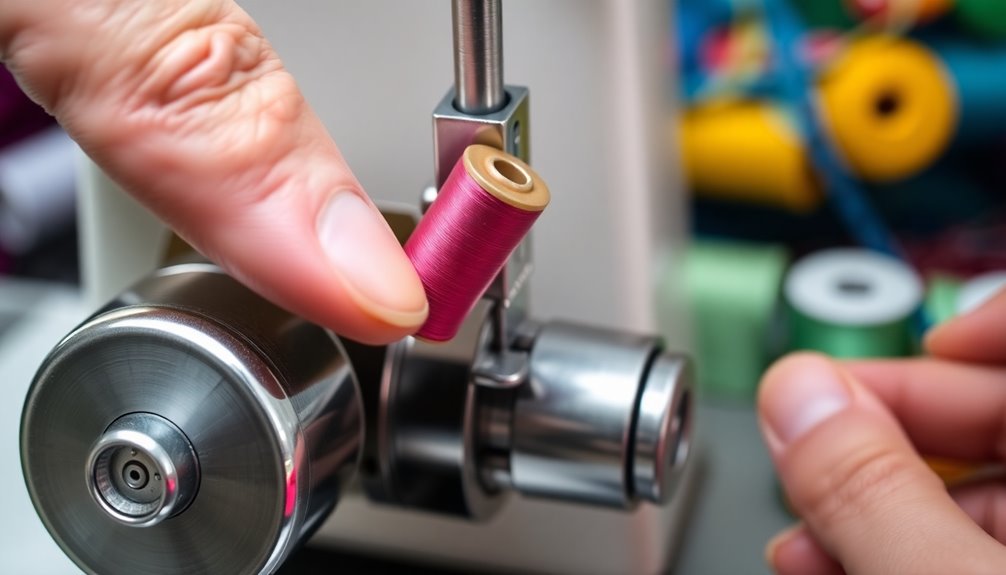
Choosing the right bobbin size is vital for smooth sewing operations. Always use bobbins that match your sewing machine's specifications; mismatched sizes can lead to thread tangles and jams, causing the handwheel to stick.
When inserting the bobbin, make certain it's seated securely in the bobbin case. An incorrectly inserted bobbin can obstruct the handwheel's movement.
Regularly compare new bobbins with your machine's original ones to verify the correct bobbin size and avoid jamming issues. Proper placement is vital too—make sure the thread unwinds in the correct direction and threads through the tension mechanism properly.
If you experience jams, check the bobbin area for damage or debris that could hinder its function and cause further issues.
Maintenance and Cleaning Tips

Ensuring your sewing machine runs smoothly involves more than just using the right bobbins; regular maintenance and cleaning are key to preventing jams, especially with the handwheel.
Start by powering off your machine and setting the handwheel in the down position for safety. Use a small brush or tweezers to carefully remove any accumulated debris and lint around the handwheel. This simple step can greatly improve its movement.
Next, apply a small amount of WD-40 or a suitable lubricant to the handwheel, letting it sit for a few minutes to penetrate stubborn grime. Regularly checking the air quality around your workspace can also help prevent dust accumulation on your machine.
Regularly check and lubricate the handwheel and internal gears to prevent future sticking. Always remember to turn the handwheel anticlockwise for any adjustments.
Identifying the Jam
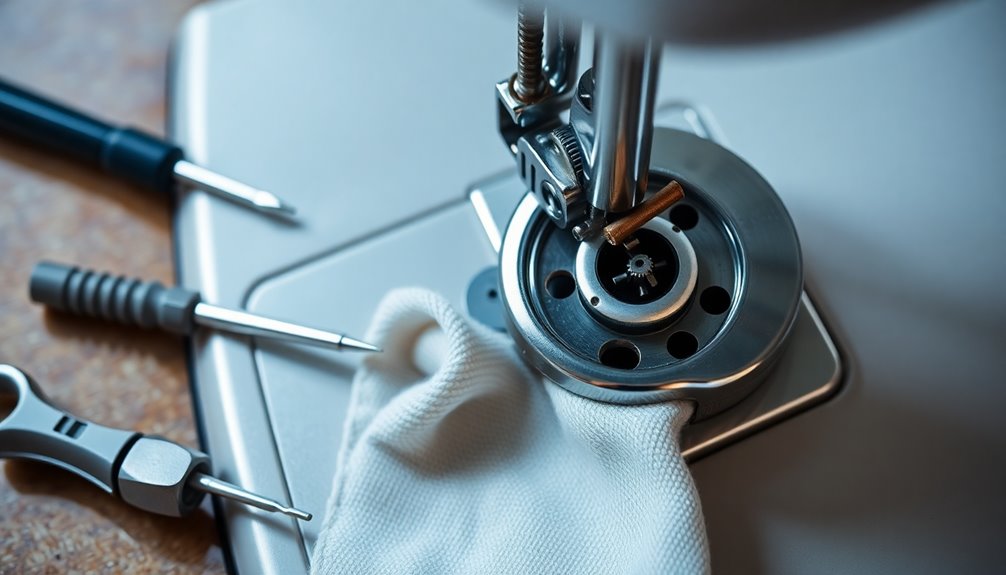
When your sewing machine starts making a grinding noise, it's a clear sign that something's jammed in the handwheel or needle mechanism.
If you're struggling to move the fabric while sewing, don't ignore it; this could mean the handwheel is stuck.
Keep an eye out for visible thread tangles or debris, as these can worsen the situation and lead to further jamming.
Common Jam Symptoms
Identifying a jam in your sewing machine is essential for maintaining its performance and protecting your projects.
A jammed sewing machine often gives off distinct signs that you shouldn't ignore. If you notice a grinding or clicking noise when turning the handwheel, that's a clear indicator of obstruction. You might also struggle to move the fabric through the machine, with the needle failing to penetrate properly.
If the handwheel feels stuck and won't rotate, debris or tangled threads could be blocking the internal mechanisms. Regularly inspect for loose threads or improperly threaded bobbins, as these can unexpectedly cause your machine to jam.
Catching the jam early can prevent further damage and save your fabric from unnecessary wear.
Noise During Jamming
A jammed sewing machine often gives off a distinct sound that can help you pinpoint the issue. Pay close attention to the noise your machine makes; it can reveal a lot.
Here are some sounds to listen for:
- Grinding noise when you turn the handwheel
- Clicking sounds during needle movement
- Sudden silence when fabric jams
- Changes in the machine's rhythm
These noises usually indicate the needle can't complete its motion due to an obstruction. You might also notice the fabric's movement becomes tricky.
Identifying the jam early is essential to prevent further damage. If you hear anything unusual, consider cutting excess thread carefully to avoid complicating the issue while you resolve it.
Fabric Movement Issues
Fabric movement issues can be frustrating, especially when they lead to a jam in your sewing machine. You might notice a distinct grinding or clicking noise, signaling that something's obstructing the needle or handwheel.
When fabric movement is hindered, you'll feel sudden resistance while sewing, making it difficult to feed the material through the machine. To preserve your fabric during a jam, it's wise to use scissors to cut any excess thread, preventing further damage.
Regularly check your bobbin thread length; insufficient thread can contribute to fabric movement issues. Finally, verify your presser foot is lowered properly before sewing, as this helps maintain smooth fabric movement and reduces the chances of jamming incidents.
Removing the Bobbin
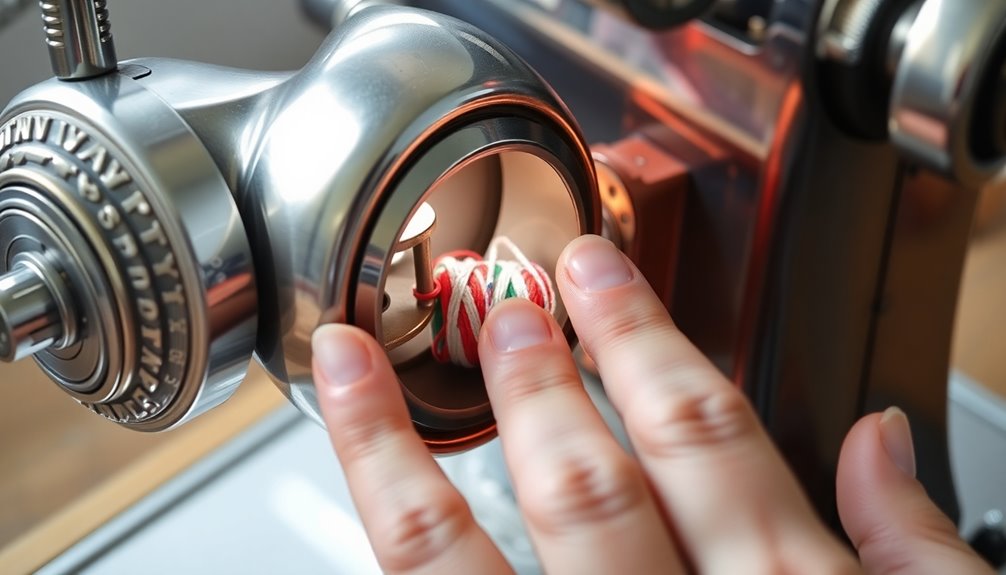
When your sewing machine jams, the first step is to safely remove the bobbin to prevent further issues. Here's what you need to do:
- Locate the bobbin case, which may be slightly sticking out.
- Gently pull the bobbin out of the case without forcing it.
- Check the thread lengths to verify they're sufficient for smooth operation.
- Make sure to place the bobbin back securely in the compartment.
Removing the bobbin correctly can alleviate the jam and prevent damage to your machine.
Always handle it with care, as improper removal can lead to further complications.
Final Steps and Testing
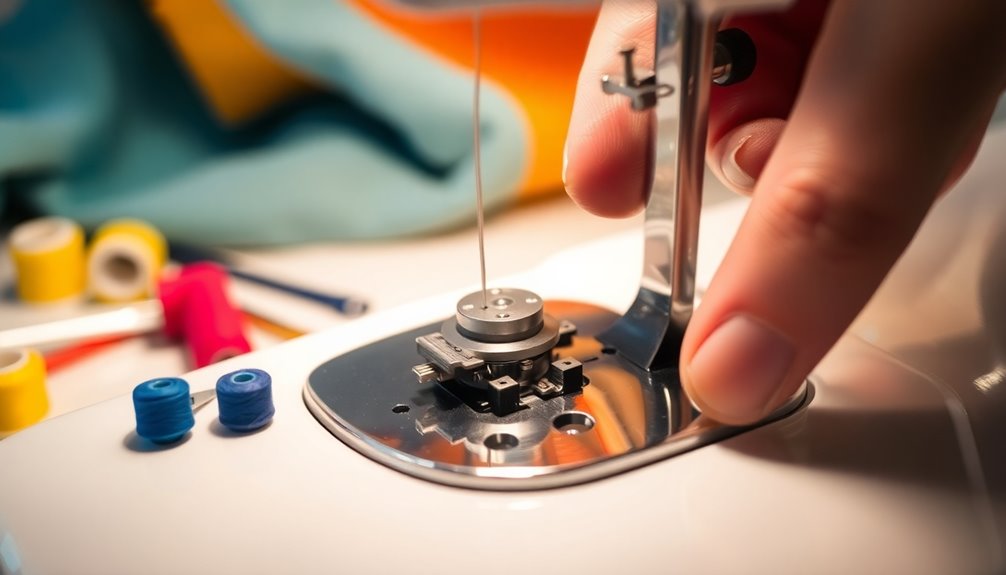
After you've successfully removed the bobbin, it's time to verify everything is in order before you start sewing again.
First, lower the needle to engage with the bobbin, then pull out the bobbin thread to ensure it's correctly positioned. Cut any excess thread that may have accumulated during the jamming process to prevent further issues.
Next, check that the needle thread is long enough, usually around 4-6 inches, to avoid any threading problems while sewing.
Now, conduct a test by sewing a few stitches and performing a backstitch to confirm the machine operates smoothly.
If everything seems fine, keep an ear out for any unusual noises or resistance as you sew, indicating potential issues may need addressing again.
Frequently Asked Questions
How to Fix a Stuck Handwheel on a Sewing Machine?
If your sewing machine's handwheel is stuck, start by checking for lint or debris around it—clean it thoroughly.
Make sure the presser foot is lowered; an improperly positioned foot can cause jams.
Inspect the handwheel for tightness; if it's loose, tighten the setscrew with a screwdriver.
Verify you're using the correct bobbin size and that it's inserted properly.
If it's still stuck, lubricate the handwheel gently with suitable oil.
How Do You Unlock a Jammed Sewing Machine?
When your sewing machine's feeling a bit stubborn, it might be time for a gentle nudge.
Start by lowering the presser foot to clear any potential blockages.
Give the handwheel a good look for debris or lint that could be causing trouble, and clean it up.
Confirm your bobbin's snug and correctly placed.
If the handwheel's still not cooperating, consider checking the setscrew or even taking a peek inside for any hidden issues.
How Do You Loosen a Sewing Machine Wheel?
To loosen a sewing machine wheel, first, check if it's securely attached. If it feels loose, remove the stitch plate and access the setscrew. Tighten it with a screwdriver if needed.
Next, inspect the area around the wheel for any debris or damage that might obstruct movement. Regularly clean and lubricate the wheel to prevent sticking, and remember to always turn it anticlockwise for adjustments to keep your machine in good condition.
What Is the Reason for a Sewing Machine to Lock Up?
Imagine your sewing machine as a car stuck in traffic. It locks up for several reasons. A loose handwheel, like a flat tire, can halt progress.
If you forget to lower the pressure foot, it's like leaving the car in gear. Using the wrong bobbin is akin to putting in the wrong fuel.
Dust and debris act like roadblocks, while damaged gears are like engine troubles. Each issue can keep your machine from working smoothly.
Conclusion
Now that you know how to fix a jammed sewing machine handwheel, don't let a little hiccup derail your creativity. Imagine you're in the middle of crafting a beautiful quilt for a friend, and suddenly the handwheel gets stuck. By following these steps, you can quickly get back to sewing and finish that heartfelt gift. Remember, regular maintenance keeps your machine running smoothly, so keep it clean and check for issues before they become a problem!
